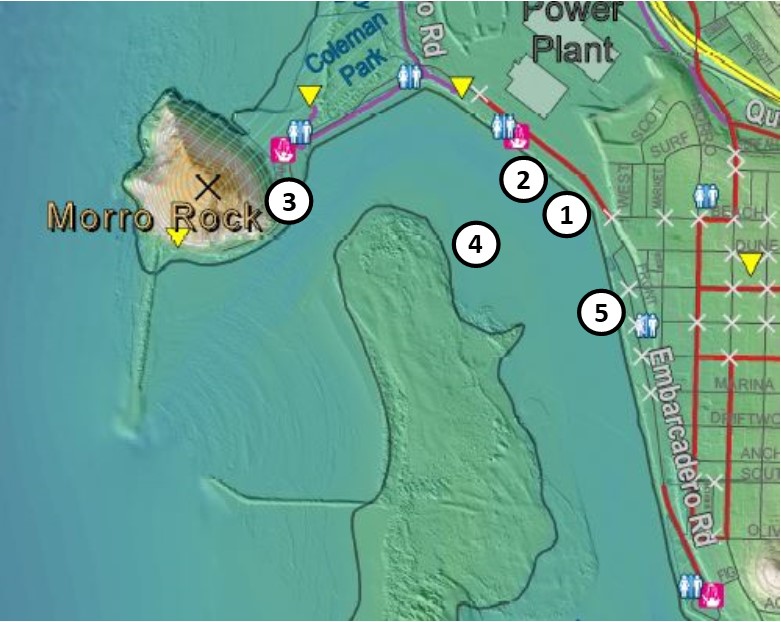The Central Coast of California is a basin of organic beauty filled with the flow of untouched nature. Glittering with fresh mist from ocean waves, the coastline holds an expansive universe known best by its inhabitants. From the hundreds of sand dollars that coat the shoreline to the families of deer snacking on nearby grass, all play a key part in maintaining the vibrant community.
Morro Bay, California upholds diverse geography making for a spectacular array of organisms that thrive on the land’s natural resources. Some of the most unique include peregrine falcons, harbor seals and the most friendly squirrels you’ll ever meet. Perhaps the most photographed and awe-inspiring is the local raft.
A RAFT, you say?
That’s right! In fact, this year host the largest raft yet. A raft is a group of sea otters resting together. Last year, there was a record number of adult otters and otter pups that were counted. A notable recovery from the fewer than 10 sea otters in Morro Bay in 2010, according to the Morro Bay National Estuary Program.
In 1977, sea otters were listed as a “threatened” species under the Endangered Species Act. According to the US Fish & Wildlife Service, their presence on the list is due to their vulnerability to oil spill risks from oil tankers. If otter fur is contaminated with oil, the fur’s insulating properties are destroyed. This phenomenon leaves many sea otters in states of hypothermia and poisoned, often resulting in death.
In 2016, the sea otter population outgrew the listing threshold of the Endangered Species Act. Sea otters will be considered for delisting after a three-year consecutive period.
Where to see them
Although the otters are seen from many vantage points, there are some hang-out spots they enjoy more than others. Here are directions to some of the best viewing locations in Morro Bay:
-
South T-Pier
Just south of Great American Fish Company is a little T-shaped pier perfect for bay watching and otter spotting. Our otters love to congregate around this pier in search of food along the bay’s floor. Bring your camera, you will regret it if you don’t! Be sure to #MorroBay all your photos, we would love to see or repost them.
we would love to see or repost them.
-
Harbor Walk
Across the street from the tall smoke stacks is the start of Morro Bay’s harbor walk. This pathway circumnavigates the water’s edge and is friendly to bikes, strollers, walkers, joggers and pups. The otters love to swim alongside the pathway making for a delightful treat along your excursion. The pathway leads to Morro Rock’s parking lot.
-
Target Rock
This is the locals’ name for a giant rock that sits at the entrance to Morro Rock’s parking lot. If you’re near the Rock, you will likely see otters swimming in the bay below target rock. Be sure you are looking toward the bay. You won’t see otters if you’re looking at the ocean waves on the other side of the lot.
-
On the water
Perhaps the most special way to see our otters is by kayak, boat, canoe, paddleboard or even swimming! Be sure to keep a safe distance. If they notice you, you’re too close! There are several locations to rent out a vessel for the afternoon. Check out http://www.morrobay.org/things-to-do/outdoors to find a rental store.
-
From your dinner table at one of our many waterfront restaurants
Strategically equipped with floor-length windows and patio tables, many of the restaurants along the Embarcadero are great locations to spot otters swimming in the bay. Expect an evening of serendipity, as you will see more than sea otters in the water.
How to help
Here’s some tips to help sea otters, from the Morro Bay National Estuary Program:
1. Give otters their space: While sea otters may look like they’re lounging, being an otter is hard work. Much of their play-like behavior—rolling over, rubbing their fur, and licking themselves—is necessary to keep them buoyant and warm. If they aren’t grooming or sleeping, they’re likely to be hunting. Otters need to eat 25% of their body weight each day in order to generate enough energy to keep going in cold water. Keep a distance from the otters so they can successfully hunt for food.
2. Pick up after your pets: Toxoplasma gondii is a parasite that infects many domestic animals. The eggs can live for months or years in feces. Unfortunately, this parasite can be fatal for sea otters. To reduce the risk of infecting sea otters, you should always pick up after your dogs and cats (both indoors and out).
3. Report stranded or ill otters: If you see a struggling or stranded sea otter, please call the Marine Mammal Center at (415) 289-SEAL (or 7325). They will help the animal, if possible.
Mating and pupping occur year-round, however the peak of mating season is typically October through January. Come anytime now through spring to see the newborn pups up close! For more information about the best viewing locations, call the Morro Bay Visitor Center at (805) 225-1633.